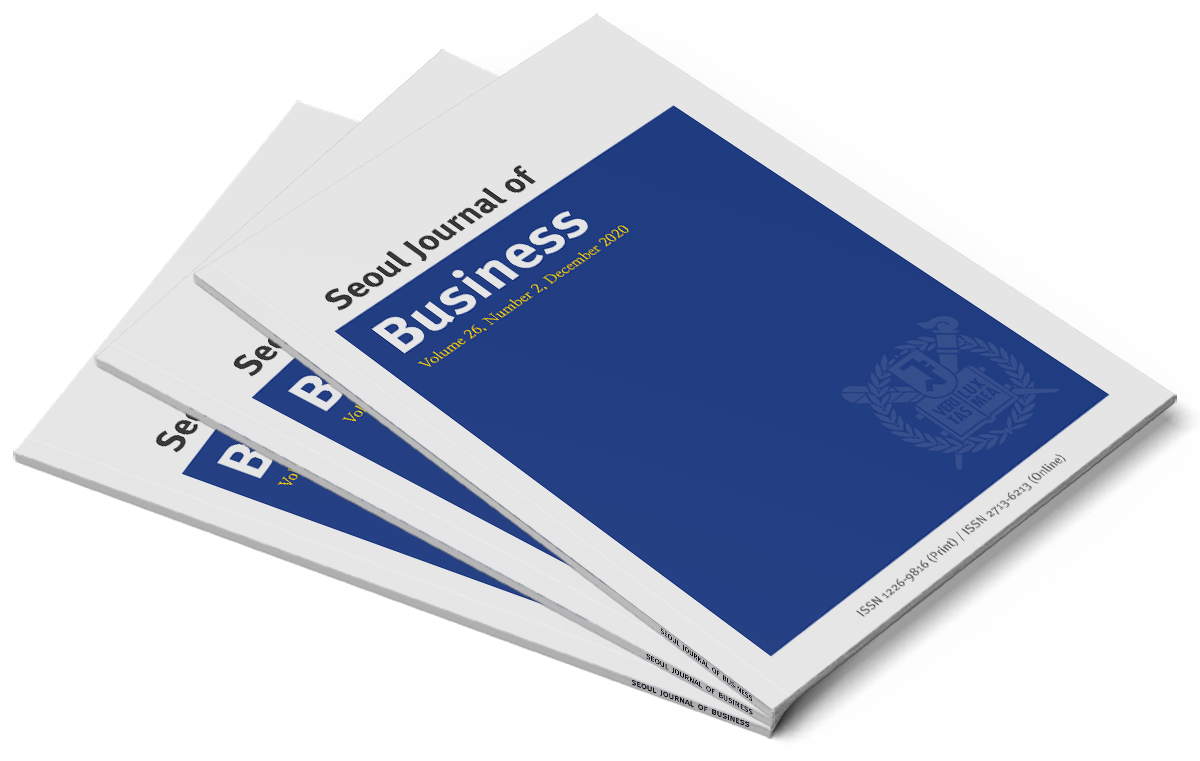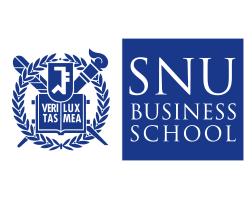Recent Issues
Vol.21/2 (2015, December)
Impact of Controlling Shareholders on Corporate Social Responsibility under External Financial Constraints
Author HEE SUB BYUN, JI HYE LEE, KYUNG SUH PARK
Keywords controlling shareholders, conflict of interest, corporate social responsibility, external financial constraints, Korea
Download
This study examines the relationship between the ownership of controlling
shareholders and corporate social responsibility in Korea under external
financial constraints. Empirical results show that a negative relationship is
observed only in firms with fewer external financial constraints, while it is
weaker or disappears for firms with more financial constraints. We obtain
similar results when we use the level of environmental management as a
proxy for corporate social responsibility. These results confirm that external
financial constraints act as a monitoring mechanism and mitigate the
agency problem of controlling shareholders.
Vol.21/1 (2015, June)
The Chicken Game and the Amplified Semiconductor Cycle: The Evolution of the DRAM Industry from 2006 to 2014
Author JEHO LEE
Keywords Cycle, DRAM, Technology, Innovation
Download
Industry fluctuations in the supply of DRAM chips relative to demand
have been characterized by what is called “the silicon cycle.” In the period
between 2006 and 2008, the DRAM industry experienced an unusually
sharp transition from a shortage of DRAM products to an extreme
oversupply, culminating with the crash of DRAM prices in 2008. The
industry’s overcapacity was preceded by a mad race to expand capacity;
this race has been dubbed as the “chicken game” in the media. Even in the
time of plunging DRAM prices, players preferred not to reduce their output.
The amplified industry cycle accelerated the exit of financially vulnerable
firms. I argue that the combination of the amplification of cycle and rising
entry barriers fosters the transition of an industry to an oligopoly, in which
cyclicality is curbed and the positions of market leaders are solidified.
Vol.21/1 (2015, June)
Costing Rule and Cost Behavior in the Korean Defense Industry
Author HONG-JUNG YONG, TAE-SIK AHN, HYUNG-ROK JUNG, JIN-HA PARK
Keywords cost stickiness, labor costs, defense industry, commercial sector, defense sector
Download
This paper investigates the cost behavior in the Korean defense industry.
Managers in the defense industry tend to have motivation to manage
earnings because the costs incurring in the production process of defense
articles are reimbursed based on cost plus contracts. Results are as
follows. First, in the sample of the defense sector, SG&A costs and total
manufacturing costs exhibited anti-stickiness whereas labor costs exhibited
cost stickiness. Other cost components displayed symmetric cost behavior.
Next, in the commercial sector, material costs, direct material costs, total
manufacturing costs, cost of goods sold, and total costs exhibited antistickiness.
Labor costs showed cost stickiness whereas SG&A costs,
overhead costs, and indirect production costs had symmetric cost behavior.
Overall, the results reveals that the change rate of labor costs of the defense
sector exhibits more cost stickiness to changes in sales than the commercial
sector.
Vol.21/1 (2015, June)
The Impact of Leader’s Humor on Employees’ Creativity: The Moderating Role of Trust in Leader
Author DEOG-RO LEE
Keywords humor, humor style, individual creativity, trust in leader
Download
The purpose of this study is to examine how leader’s humor styles
influence employee creativity, and the moderating effects of trust in
leader on the relationships between leader’s humor styles and employees’
creativity. The results using 316 valid leader-subordinates pairs (71 leaders
and 316 subordinates) from five telecommunication companies in South
Korea showed that leader’s self-enhancing humor was positively associated
with subordinates’ individual creativity, and leaders’ aggressive humor was
negatively associated with subordinates’ individual creativity. In addition,
trust in leader significantly moderated the relationship between selfenhancing
humor and employee creativity. Specifically, the relationship
between self-enhancing humor and employee creativity became stronger as
trust in leader increased.
Vol.21/1 (2015, June)
Building a Korean Fashion Platform in Taobao, China’s Biggest Online Commerce: The Case of Fashion e-Commerce Company Accommate
Author TONGYO HAN, BYUNGJOON YOO, SEONGMIN JEON
Keywords Online marketplace, Alibaba, Taobao, Tmall, Fashion, e-Commerce
Download
In 2008, a Korean online fashion distributor, Accommate, is founded in
China and it tapped into the Chinese online market with the alliance of
Taobao, online C2C(consumer-to-consumer) commerce platform of Alibaba.
Taobao offered free listings to attract more sellers in order to compete e-bay
and introduced keyword search features which Accommate made use of as
an early adopter and partner. As Taobao became China’s market leader,
Accommate secured the partner position to distribute Korean apparels
and strengthened its partnership with Alibaba. Soon Alibaba introduced a
new online brand mall called Taobao Mall or Tmall to complement the C2C
platform. Accommate extended its business with Alibaba by taking charge
of the Korean product sections in the online brand mall of Tmall. From the
perspective of scales, China represented for Accommate a dynamic and
fast-growing market, though it is so competitive. Moreover, it is a tough job
to manage the adequate level of inventory for clothes which have as short
lifecycle as 45 days. A number of Korean predecessors failed to manage
cash flow issues resulted from the inventory.
Accommate came to encounter the management issues of both meeting
the changing requirement of Chinese customers and managing the
inventory level at the same time. Considering these changes and challenges,
we may well think what the strategic and operational issues regarding
Accommate are and how the company should grow in this fast growing
electronic marketplace. This case study will help readers think about the
emerging electronic market in China and form an opinion on the associated
management issues and analyses.
Vol.21/2 (2014, December)
Erratum to “Risk and Reward in Venture Capital Funds” by Joon Chae, Jee-Hyun Kim, and Hyung-Chul Ku
Author Erratum
Keywords -
Download
-
Vol.21/2 (2014, December)
Search Behavior and Catch-up of Firms in Emerging Markets
Author Yuzhe Miao and Jaeyong Song
Keywords catch-up, search behavior, China, innovation, patent, technology
Download
This study investigates catch-up in the form of knowledge creation of firms in emerging markets by stressing two distinct types of search behaviors of an organization – horizontal search and vertical search. Based on an empirical analysis of 204 Chinese firms, this study provides new theoretical insights into and practical implications by emphasizing that in order to catch-up, firms in emerging markets should adopt idiosyncratic search strategies different from those of firms in more advanced countries. The regression results show that due to their under-developed absorptive capacity, firms in emerging markets should avoid searching in diverse knowledge fields, as established large firms in advanced countries are encouraged to do, in order to innovate successfully. Our findings also suggest that searching for recent and emerging knowledge helps firms in emerging markets overcome their learning curve disadvantage in the process of catch-up.
Vol.21/2 (2014, December)
Social Exchange Model between Human Resource Management Practices and Innovation in Software Engineering
Author Donghyun Kim and Youngkeun Choi
Keywords human resource management practice; social exchange theory; affective organizational commitment; innovative behavior; software engineering
Download
This study examines the relationship between human resource management practices and innovation in software engineering. We use social exchange theory to investigate how human resource management practices influence the innovative behaviors of software developers through the mediation of affective organizational commitment. The results show that developmental appraisal, externally or equitable reward, and comprehensive training increase developers’ affective organizational commitment, which in turn positively affects their innovative behaviors.
Vol.21/2 (2014, December)
The Sequential Relationships among Operational Capabilities and Performance in Service Industry: An Empirical Study
Author Jungeun Cho
Keywords service industry, operational capability, service resource, customer experience
Download
This study seeks to identify the elements of operational capability and obtain a detailed picture of the sequential relationships among operational capabilities and business performance in the hospitality industry. In addition, it attempts to prove that the capability to offer an enhanced customer experience constitutes a core competitive advantage in service firms. A phone survey was conducted among Korean hotels, and 102 data sets were collected. Structural equation modeling and multiple regressions were used to test hypotheses using the survey data.
As a result, it was discovered an optimum path for the accumulation of operational capabilities in the hospitality industry and customer experience is revealed to be the only dimension of operational capabilities that is directly linked to market performance.
Vol.21/2 (2014, December)
The Effects of Design Attributes on Other Attributes and Product Evaluation
Author Sang-Hoon Kim, So Yun Sim, and Young Eun Hahm
Keywords Design, product development, high-tech marketing, attitudes toward design
Download
This study examines how consumers’ perceptions of a product’s design attributes influence their perceptions on other product attributes, and attitudes toward the focal product. This study explored image-related adjectives in order to analyze product attributes, which are categorized into design, symbolic, and functional factors. The empirical test results confirmed the mediating role of attitudes toward design, which indicate the overall preference about product design, between design attributes and attitudes toward product, while the hypothesis of the moderating role of design sensitivity was not supported. These findings revealed that design attributes have influences beyond the aesthetic value, as product design rouses symbolic value and delivers information about functions. Therefore, in the context of product development process, it would be effective to distinguish design elements that can strengthen advantages and supplement weaknesses and to measure attitudes toward design that can be an important index of product evaluation.
Seoul Journal of Business

ISSN 1226-9816 (Print)
ISSN 2713-6213 (Online)
ISSN 2713-6213 (Online)


